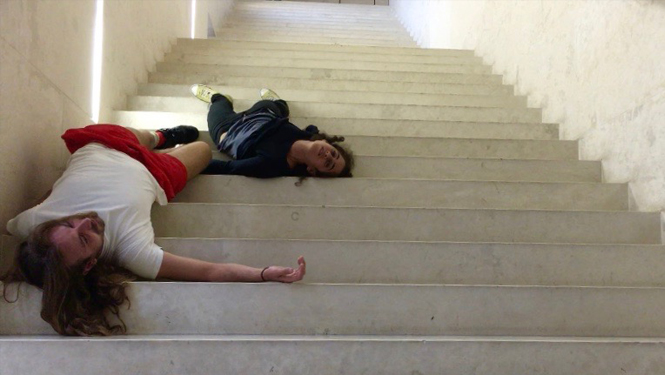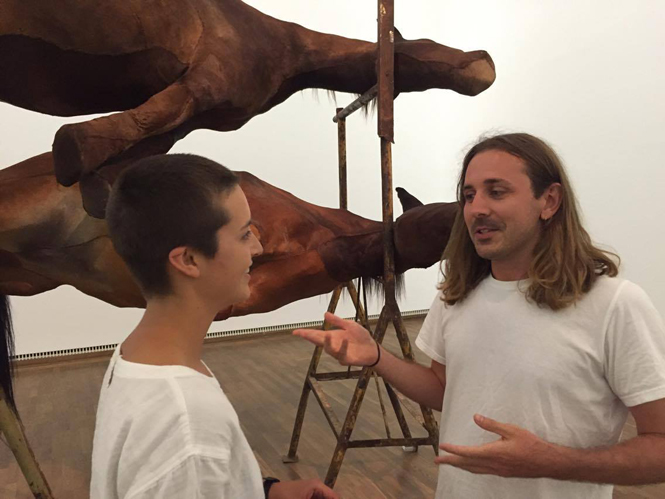danceWEB 16

Chris Scherer (left) participating in Jan Mot and Maria Hassabi’s workshop ‘With Maria and Jan’ with fellow danceWEBer Salma Abdel Salam
Chris Scherer’s report
As I’m sitting in my kitchen writing this report, I feel confronted by the memories of my 5 week experience in danceWEB 16. I’m asking myself how can I best articulate the deep connections I made with so many other beautiful artists? What exactly did I take away from the many classes, workshops and performances? And, most difficult, how to express here, the unbelievably rich experience that 65 of us lucky people from all over the world just went through?
I can only think of one other time in my life, which was when I participated in Tino Sehgal’s ‘This Variation’ at dOCUMENTA 13, where I connected so profoundly to a large group of people in a relatively short period of time . On the last day, as tears were rolling down our faces, we said “see you tomorrow” instead of “goodbye”, in an attempt to soften the reality that we won’t see each other for weeks, months, years, or possibly ever again. There was a hope – and what is already turning into a reality – that the bonds that were formed during this experience will grow into a wonderful, supportive artistic network.
DanceWEB is a combination of participating in classes and workshops, seeing shows, living together, socialising, partying, networking, being mentored and presenting work. It forms a concentrated bubble. For me, it generated a highly focused learning environment where you can extend your professional skill-set while also placing an attention to collectivity with other artists of different ages, experiences, cultures and disciplines. As an outcome, an extremely strong artistic community was established with people with whom I never would have possibly had the opportunity to meet, otherwise. We formed collaboration, support and strength through this new network. To me this is a huge part of what danceWEB was, and is. It’s a time where a focus on the social was feed by the artistic.
In just the few weeks since the program has finished, there has been a drive from within the group to see how this experience can be consolidated into something more permanent. We have been active in forming a collective and we will have our first meeting in Paris in November 2016. Although not everyone can attend this, there is a large majority of us that can, with others joining us online from Sao Paulo, Berlin, New York, Cairo, Sydney and Tehran. We are yet to finalise an official name for the collective, but there is a large email thread growing with the desire to find something that best represents the group. In addition to this, we have shared playlists of music, emails about creative opportunities, a never ending WhatsApp group for more personal chit-chat and online documents that articulate residencies and performance opportunities from our respective communities. In addition to this, people have also already began to feed into one another’s work as performers and collaborators.
While this collective and community is a wonderful long-term outcome of the experience, it does overshadow the actual danceWEB experience in Vienna, itself. Within danceWEB, one can cater the program to their particular interests. I myself participated in a lot of intensives from the ‘Visual Arts X Dance’ program, a workshop series curated by Tino Sehgal, Louise Höjer and Rio Rutzinger. In these workshops, there was a pairing of artists who are working within the visual arts context with dance practitioners. As this form of collaboration is of particular interest to me, I could curate my danceWEB experience in this direction. I took workshops from Calla Henkel, Max Pitegoff and Angela Schubot, Mario Garcia Torres and Maria Francesca Scaroni, Trajal Harrell and Anri Sala, Jan Mot and Maria Hassabi, Moriah Evans and Judith Rohrmoser, and lastly Asad Raza, Märten Spängberg and Adrian Villar Rojas. These workshops had a very different rhythm to what I imagine would be available to danceWEBbers in other years. They all had some kind of physical practice but there was a real attention to critical research and discourse. There were many questions that were addressed throughout these 5 weeks, including intimacy, using the body as material, museums and equality, modernity, domesticating dance, aesthetic production, syntax, archiving, gazing vs glancing, portraiture and codification. I found these discussions were super informative to my current artistic practice and extremely useful to the the work I am currently busy with as a maker.
One thing that is a little problematic about danceWEB is that you can’t do everything. There are so many options! Although I am very happy with my choices of how I spent my time, I feel as though I had to ‘sacrifice’ the opportunity to do more formal dance classes. I did manage a week of Janet Panetta’s Ballet and Archie Burnett’s Voguing classes towards the end of the experience which felt like a real treat, different from the conceptually heavy work within the ‘Visual Arts X Dance’ workshops. I also participated in weekend workshops from Doris Uhlich and Keith Hennessy which I enjoyed tremendously. I am appreciate enormously the opportunity to see 60 performances, indiscriminately, during this time period. I saw some shows that I loved, and others that were not my cup-of-tea, so to speak, but it really helped me realise both my expectations of dance and why I make my particular ‘genre’ of work.
I am extremely grateful to the Tanja Liedtke Foundation for co-financing my danceWEB scholarship. Thank you for allowing me this experience.

Chris Scherer testing some performance material with fellow danceWEBer Ivey Wawn at the Leopold Museum
